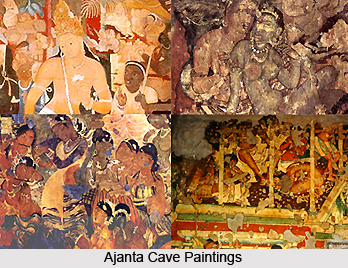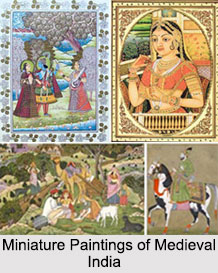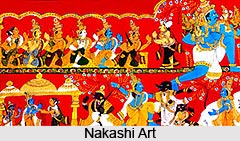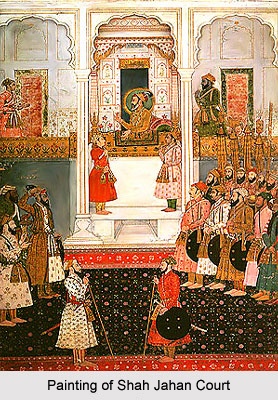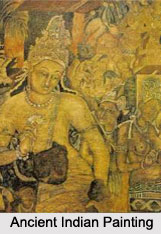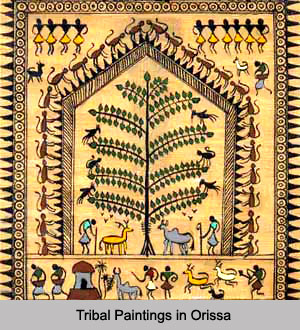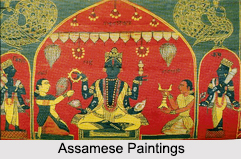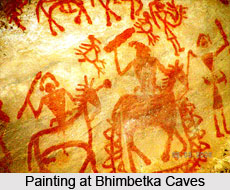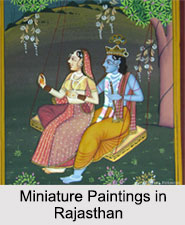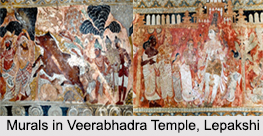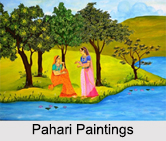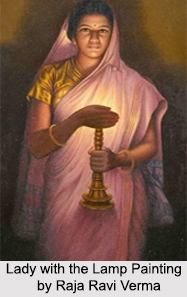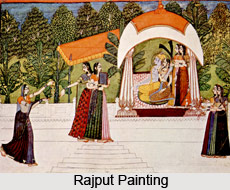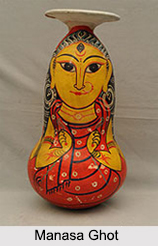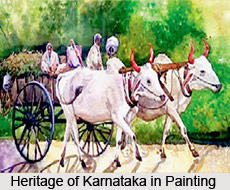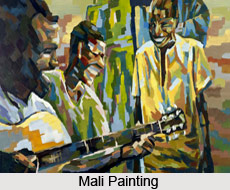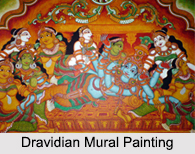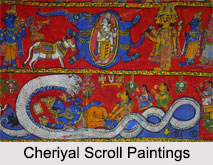Ragamala school of paintings comprise beautiful paintings which are pictorial illustrations of the six principle ragas: Bhairava, Dipika, Sri, Malkaunsa, Megha and Hindola which are meant to be sung during the six seasons of the year; summer, monsoon, autumn, early winter, winter and spring. In the 12th century AD, the Sarigeetaratnakara, an important treatise first mentioned the presiding deity of each raga. A raga is a melodic approach, which literally means `to colour`, or even clarified as a permutation and combination of notes or frequencies illustrated by melodic travels and whereabouts. It is often taken into consideration that that these melodies are capable of producing a soothing sensation, mood or an emotion in the listener.
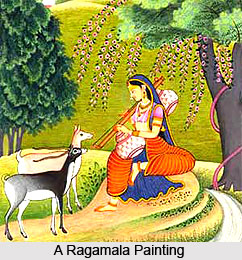 The Ragamala paintings are the visual interpretations of the numerous musical notes, transcending beyond the ephemeral mundane. The Ragamala paintings were created by all the major schools of painting of the medieval age such as the Mughal, Pahari, Deccani and Rajasthani creating ripples during the 16th to 19th centuries A.D. A very selective range can also be seen in several personal collections.
The Ragamala paintings are the visual interpretations of the numerous musical notes, transcending beyond the ephemeral mundane. The Ragamala paintings were created by all the major schools of painting of the medieval age such as the Mughal, Pahari, Deccani and Rajasthani creating ripples during the 16th to 19th centuries A.D. A very selective range can also be seen in several personal collections.
The Muslim kingdoms of the medieval Deccani Sultanates of Ahmadnagar, Golconda and Bijapur patronized all forms of the fine arts and literature. So, they produced numerous luscious paintings in South India during their age. According to some scholars, Ragamala paintings had their origin in the Deccan during 1580-1600 A.D.
Romantic or devotional themes are mainly used in the Ragamala paintings. In these paintings, themes such as separation, anger, anxiety, devotion, etc. are beautifully highlighted. The heroines are painted as playing instrumental music to animals like the deer or to snakes, which appear mesmerized by this enchanting music. The intensive feeling of Raga Vasanta renders its mellifluous voice in the following poem where the rhetoric words articulately paint the frolicsome and zealous character of the mode. The Cock (Kukkutaka) sings the musical mode Vasanta, the Spring.
"Chupayi!!
Saras basant sashi sushdayi riti vasnt pels aya ban aayi !!
Purush besh dhari kaa miyii gaavahi
Sashi sang sav saj banvahi!!
Varsha anup fuli amrayi gunjahi
Bhavar baas gahraayi!!
Mand sugadh payi sushkaari
Piya samip sush bilasahi naari!!
Gaavahi sashi kokala baayi chatur
Sabad sangeet bshayi!!
Doha!!
Gaavat naachat ras magna phirat saghan ban kunj!!
Piya Deepak manbasikarau tehi basant sushapunj!!"
In the garden, made to play, in swarm of bees which are keen on the scent of flower with fresh leaves, praised by (the God) shakra being at their head, that is Vasanta who is wearing a wreath, a crown and a horn as a wind instrument, who is having a betel lump in his mouth, is resembling ratis spouse of Kama the God of love and has started great laughter in the turmoil of all musical instruments in the company of women. The spring putting the shape of Krishna that is the song she sings. Add with all her companions have made herself fair. Unparallel colour, mangoes in flower sited upon them is the swarms of deep murmuring bees. Soft are the scented zephyrs and the water very pleasant. Woman disported in delight beside their lover lord Krishna. Her comrade sings with the Kokila voice.
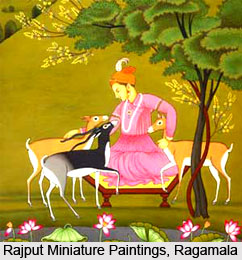 Raga Vasanta is always represented in the paintings as Lord Krishna dancing joyfully on the enchanting music played by gopis, the milkmaids. The striking beautiful love-tender and sensuous God clad in yellow silk was popular subject of song, dance, drama and paintings. The Raga represented as Krishna is personified like Devata or God of a mantaram and is regarded as the Purusha, an eternal male. The gopis, the lovely milkmaids are seen as jeevatmas, the individual human souls, craving merger with the Parmatma, the Supreme soul, Lord Krishna. The painting also aims at corresponding with the poetry.
Raga Vasanta is always represented in the paintings as Lord Krishna dancing joyfully on the enchanting music played by gopis, the milkmaids. The striking beautiful love-tender and sensuous God clad in yellow silk was popular subject of song, dance, drama and paintings. The Raga represented as Krishna is personified like Devata or God of a mantaram and is regarded as the Purusha, an eternal male. The gopis, the lovely milkmaids are seen as jeevatmas, the individual human souls, craving merger with the Parmatma, the Supreme soul, Lord Krishna. The painting also aims at corresponding with the poetry.
Raga Vasanta is designated as a secondary mode or Ragini in some traditional and musical texts. However in the paintings it is always projected as a masculine character more prominently lord Krishna. The poems also conceptualized the iconography of the melody in a male form in spite of it being subsumed as a female mode or Ragini in the musical treatise.
Ragamala painting also depicted the themes like the hero and heroine in various situations such as dancing, singing, the heroine weary of waiting for her lover and later infuriated with him. These paintings mainly sketch the `Rasa` or flavour of a particular raga. The Ragamala artists of the Deccani schools were mainly guided by the Persian or Urdu text versions available during that period.
Ragamala paintings conspicuously colours the human psyche with some definite feeling, an amalgamated wave of juxtaposed emotional passion. They redefine aesthetic grandeur, without recourse to annals or anecdotes. Their principal dealing is with Rasa - the aesthetic emotion, the subject matter - the motif other melody. The atman or the soul inhabits a body so does every Rasa incarnates the Rupa or raga or Ragini. The Rasa in the presiding theory of a raga is rendered by none but human work - in replacement of imagism through symbolic icons.
The bhava dictated in the painting under rueful observation is Vibhava or excitant, a stimulus which ignites the erotic taste the painting portrays both kind of Vibhava, which sustains love and uddipama cause of excitement. The hero and heroine are essential or material ingredients while gopis, trees, birds, flowers, ornament, beautiful clothes, dance, music, swaying of the body, side glances are other excitant factors generating the flavour of the season. The poem and the paintings try to impel the Sthayi bhava or underlying emotion. An underlying emotion or sentiment thrives to be the ultimate ground basis of a Ragamala poetic work or painting and is the permanent condition like the thread of a garland, not over powered by them but only reinforced.
Ragamala paintings also have glimpses of another theme prevalent at the time that is Baramasa paintings or the paintings of the twelve seasons. The atmosphere created and projected during the Hindu calendar month Phalgun or western calendar March and April usually coincides with that of represented in Raga Vasanta paintings. The nature is shown quickened with a new birth and even an in animated thing seems to feel the thrill.
Thus, using mostly the neighbourhood material, the artist excelled in creating images which are easily among the most beautiful artefact ever made. Both institutions created beautiful illustration introducing new patterned styles, keeping intact the former base styles. Evocating the sensuous forms, the Kangra and Bundi school paintings transcend the stature of sense perceptions transporting one to a region of super - sensual ecstasy- an atmosphere of sublimate and spiritual emotion.
